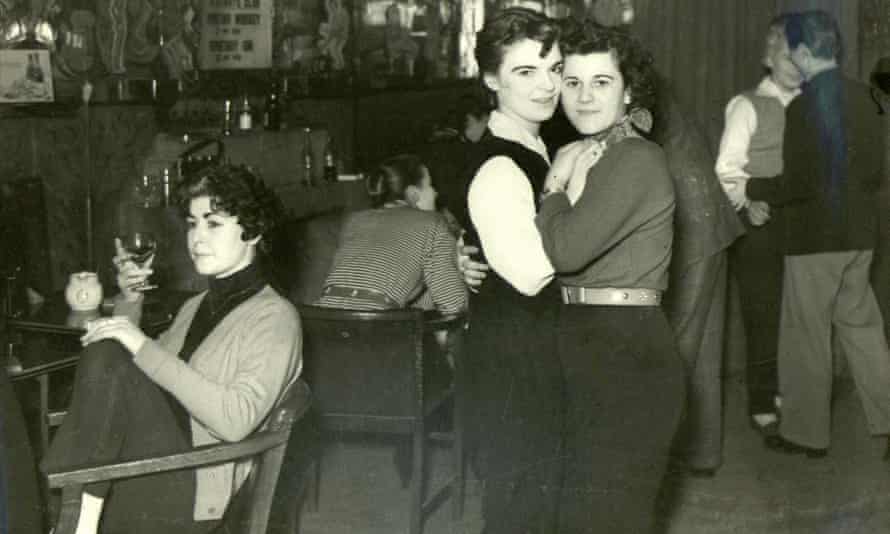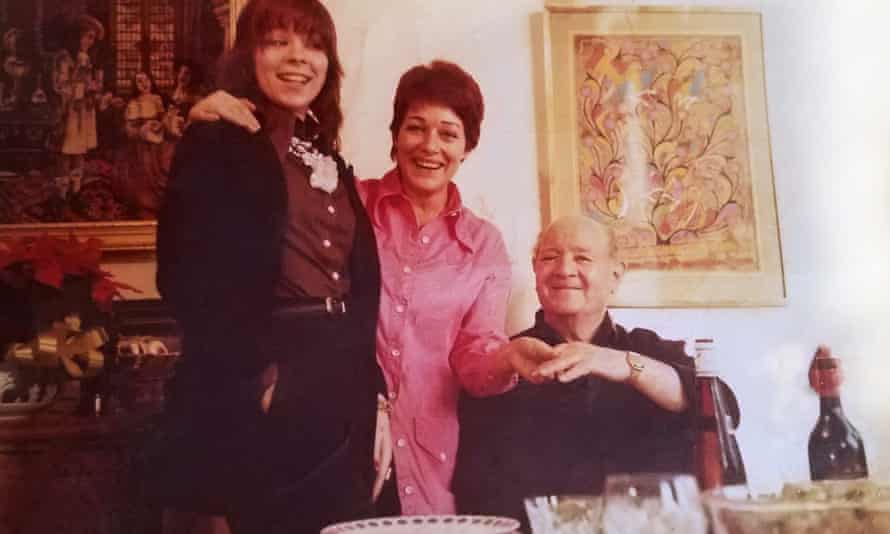The Gateways is back. The longest-running lesbian club of all-time – the one whose actual clientele appeared in the 1968 film The Killing of Sister George; the one where Mick Jagger tried to talk the owner into letting him crash in a frock; the one that was a sanctuary to every class and sort of woman, from well-known figures such as the writer Patricia Highsmith and the artist Maggi Hambling (then an art student) to swimming-pool attendants at the Tooting Bec lido – has been given a new lease of life in the first full-length documentary film to celebrate its history, and ensure that it is not erased.
Behind a dull green door on the corner of King’s Road and Bramerton Street in Chelsea, down some rickety steps to the basement lay the dive, a former strip club. The lease had been won in a bet at a broadcast boxing event at the Dorchester hotel by course bookie Ted Ware in 1943, and initially he offered it as a hang-out to a group of his lesbian pals who had been kicked out of their old Soho haunt the Bag O’ Nails pub after new owners took over and banned them.
Ted married an Italian actress, Gina Cerrato, in 1953 (they had a daughter, also named Gina, a year later) and the couple ran the club with Gina’s right-hand woman, Smithy, a former member of the US Air Force from California. They turned it into a women-only venue in 1967. After Ted’s death in 1979, Gina kept the club running but its last night was in 1985. She died in 2001.
I first met Gina Jnr (as she was never called) in Bristol in 1975 when she stood out as someone striking in a wide-striped black-and-gold form-fitting men’s suit with a Louise Brooks bob. Growing up, she says she had no idea of what sort of club her parents ran.
Family home life in the leafy mock-Tudor suburbia of Isleworth, West London, was unusual … but not to her. As well as her parents, Smithy had been invited to move in by Ted shortly after his daughter’s fourth birthday. He explained to Gina that it was in recognition of the kindness shown to him in New York as an illegal immigrant when he had been offered safe harbour by a black woman, and then a Jewish family.
There was no flamboyant atmosphere of bohemian chaos. The decor was monochrome: “My mother was never into chintz.” Bedtimes were strict; meals were served at the same hour every day; homework was not to be shirked; a neighbour would take her to church every Sunday. But Gina was aware that her family was more fun than her friends’ families, and if most of the people who visited were pairs of women friends, this seemed perfectly normal.
“When I went to other people’s houses I would find them extraordinarily suffocating and conventional. There’d be this ghastly father who was a boring old fart and a mother who was terribly uptight,” she recalls. “I was glad to go home to the laughter and fun. There was a lot more conversation, and I had a lot more access to my parents than my friends did to theirs. I could say what I wanted as well.”
Even as small children, she and her friends helped with jobs for the club: counting threepenny bits and sixpences from the till for the cigarette and fruit machines, and wiping down bottles of tonic water that were stored in the garage.

She was 13 when she discovered for the first time about the club’s clientele and purpose. “It was Sunday lunchtime and my mother and I were washing up after lunch. She said: ‘I want to talk to you about something because you’re going to hear about this at school. You do know what the club is, don’t you?’ I said: ‘What do you mean?It’s a club,’ and she said: ‘It’s a lesbian club, Gina.’
“I said: ‘What?’ And she said: ‘Lesbians! You know, women with women.’ So I was, like: ‘Really? Really?’”
“I think I then said: ‘Does Dad know?’ And she said: ‘He started it! It’s his club!’”
Neatly, it was a story in this newspaper about The Killing of Sister George and the club that persuaded Gina’s mother to explain.
In her mother’s final three weeks, there were a few astonishing revelations. The two Ginas were watching television together when Mick Jagger appeared and Gina Snr asked for the remote to turn the volume up, saying: “Oh, it’s Mick – such a lovely boy.”
He lived in Cheyne Walk, and would pass by the Gateways to get to the King’s Road. “And my mum would be outside, taking deliveries, doing the laundry or whatever, and she said that he used to stop and talk quite often.
“And I was, like: ‘You mean, you knew Mick Jagger?’ And she said: ‘Oh yes, and he was always so kind and respectful. He wanted to come into the club but I wouldn’t let him. He said: ‘Gina, please let me – I’ll wear a dress’, and I said: ‘Darling, I can’t – it’s women-only.’”
There was always speculation about the relationship between her mother and Smithy. On her death bed, her daughter finally asked her about it. “I said: ‘People always ask me, Mum, and I hate to ask you but were you and Smithy lovers?’ And she said: ‘Everybody always assumed that Smithy was madly in love with me and that I was playing her along. But no we weren’t, and the reason for that was that Smithy didn’t want it.’
“That was my first inkling that my mother must have been bisexual.”

Regardless of their lack of intimate relations, Smithy and Gina Snr loved each other deeply. As did Gina and Ted, who was 25 years older than his wife. “Despite their age difference, they had fun together, and there was an intellectual bond because they both had very fast, sharp minds and were clever, charismatic people.
“We lived as a family. Smithy and my mother were both with my father when he died – all holding hands and taking care of him.”
When the club closed, Gina was very sad but knew that she couldn’t take it over by herself. The documentary Gateways Grind is a way of restoring its history, which is enmeshed with her own, and to see her parents again.
It is presented by Sandi Toksvig, who recalls her own visits to the club, and has interviews with former members. It is sharp, snappy, sassy and sexy – oh, and of course, very sapphic, too. The Gateways Grind, we learn, was a particularly popular dance there where tightly meshed groin action became literally orgasmic.
Gina says she feels “immensely proud and impressed by the work and the commitment [behind the documentary] and still astonished by the interest and love that people have for the Gateways and how they remember it.
“Because we didn’t always have that. There was a time when we were out of favour because we weren’t ‘the right sort of lesbians’.” The club was subjected to demonstrations by the likes of the Gay Liberation Front who disapproved of the secrecy of the club, at a time when women could lose their children for being gay. The indomitable Gina Snr’s response was to call the police on them.
“Gateways wasn’t about being political. Being lesbian was its default position. People coming who were ‘terribly lesbian’ and ‘terribly activist’ were shocked by the fact they weren’t considered special,” says Gina.
In January 2020, an application was made to English Heritage for a blue plaque next to what was the dull green door in Chelsea. It is supported by many prominent lesbians but the outcome is still pending.
Gina’s reaction? “It is very emotional for me in the sense that I loved all those people dearly. I know what they went through. It wasn’t all fun and games. There was a lot of sorrow, a lot of harshness, life was not a bed of roses for them.
“So, yes, it’s important to have that blue plaque because it’s a location that means an awful lot to people and something genuinely happened there.”
Gateways Grind will be on BBC4 on 21 June, and screened at the Barbican cinema on Sunday 3 July along with a ScreenTalk with director Jacquie Lawrence and actors Victoria Broom and Lu Corfield